Business Functions, Interrelations, and Financial Reporting Report
VerifiedAdded on 2022/12/30
|9
|2003
|295
Report
AI Summary
This report delves into the core functions of a business, focusing on HR, Marketing, and Finance departments. It explores the responsibilities of each department, emphasizing their interrelation and collaborative working practices within an organization. The report examines organizational culture, including factors affecting it and Charles Handy's concepts. It also covers leadership styles and different types of business ownerships, such as sole traders, partnerships, and public limited companies. Furthermore, the report explains the importance of financial management and reporting, including profit and loss accounts, balance sheets, and cash flow statements, and their significance to business performance. The report concludes by summarizing the key findings and insights gained from the analysis of the business functions and financial aspects.
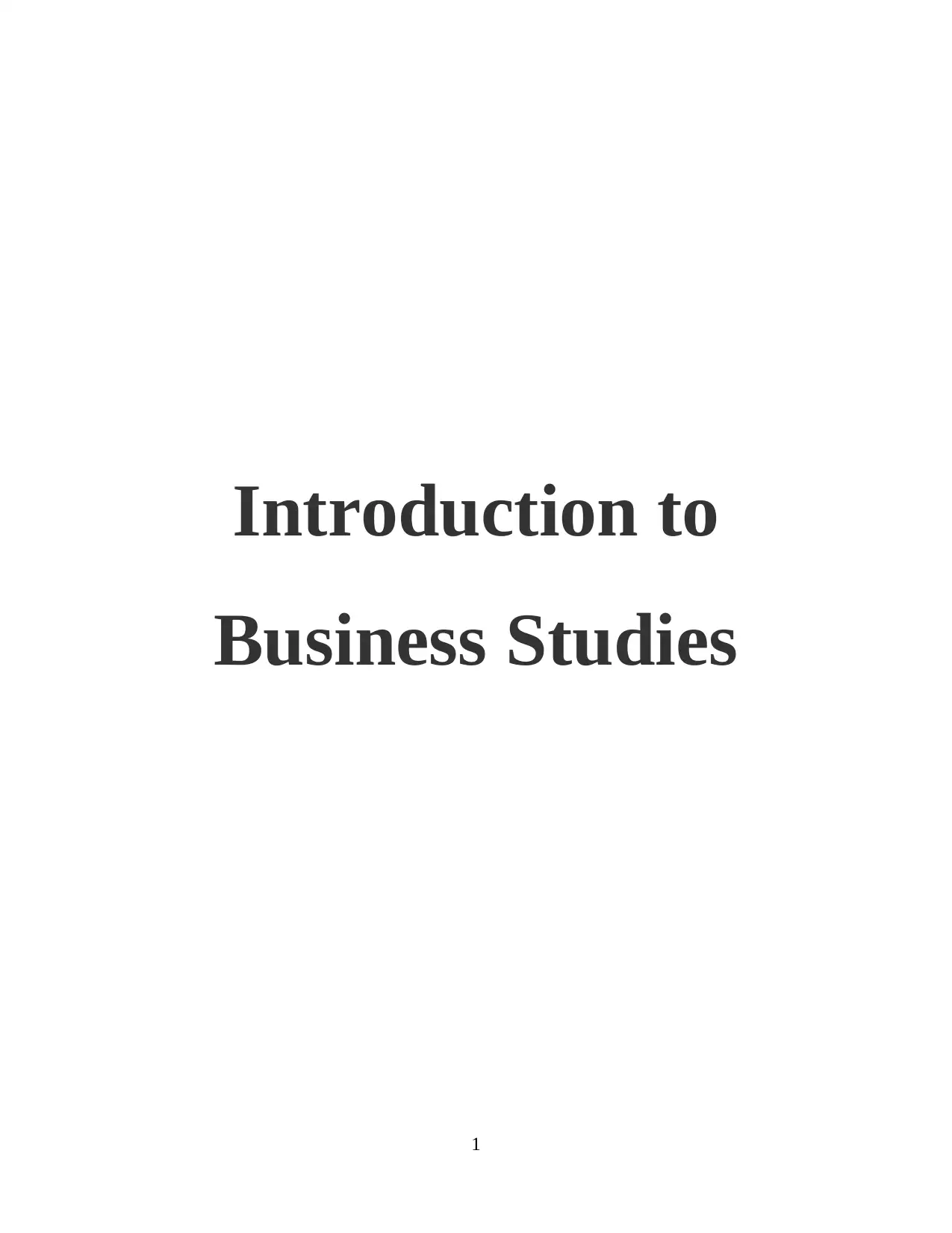
Introduction to
Business Studies
1
Business Studies
1
Paraphrase This Document
Need a fresh take? Get an instant paraphrase of this document with our AI Paraphraser
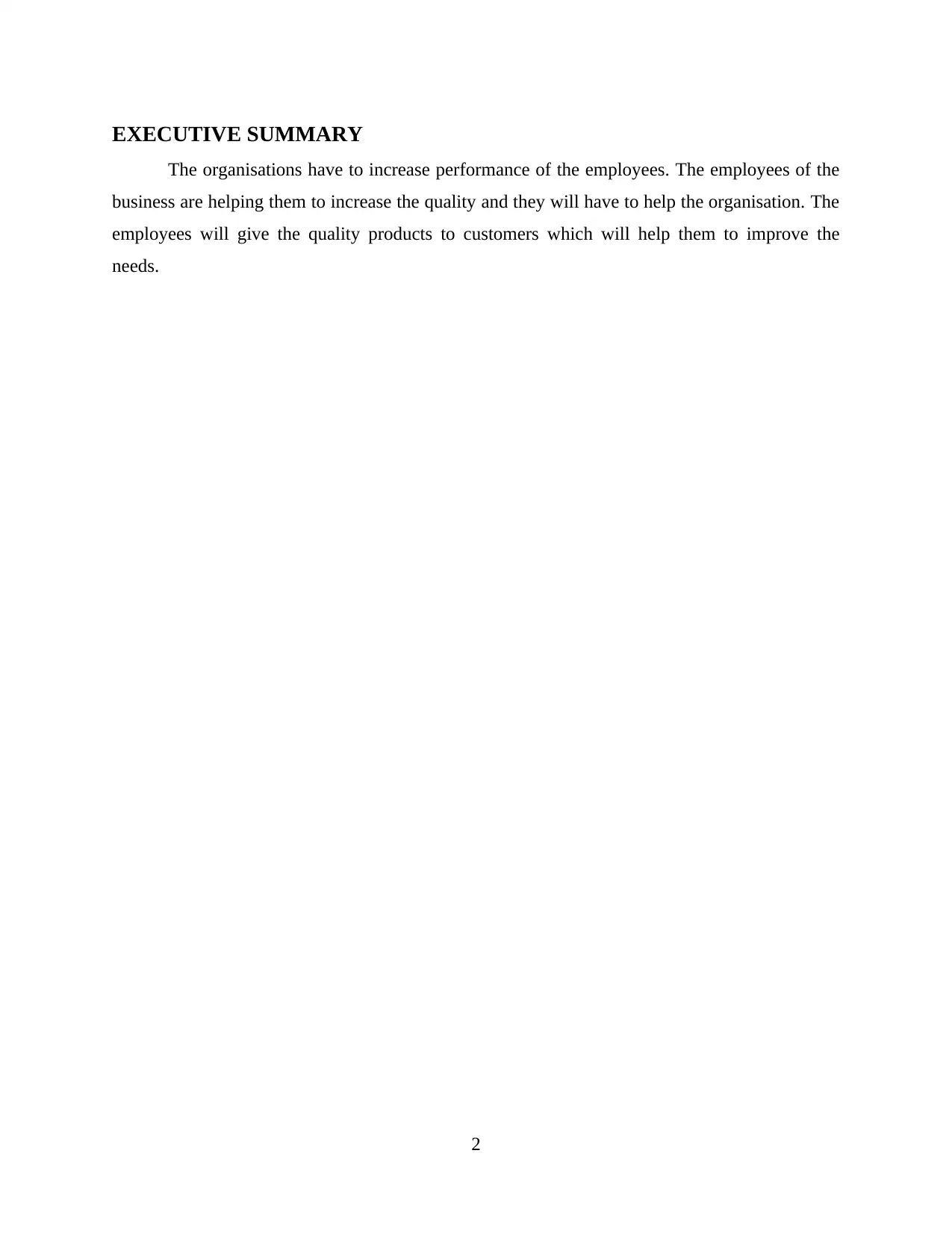
EXECUTIVE SUMMARY
The organisations have to increase performance of the employees. The employees of the
business are helping them to increase the quality and they will have to help the organisation. The
employees will give the quality products to customers which will help them to improve the
needs.
2
The organisations have to increase performance of the employees. The employees of the
business are helping them to increase the quality and they will have to help the organisation. The
employees will give the quality products to customers which will help them to improve the
needs.
2
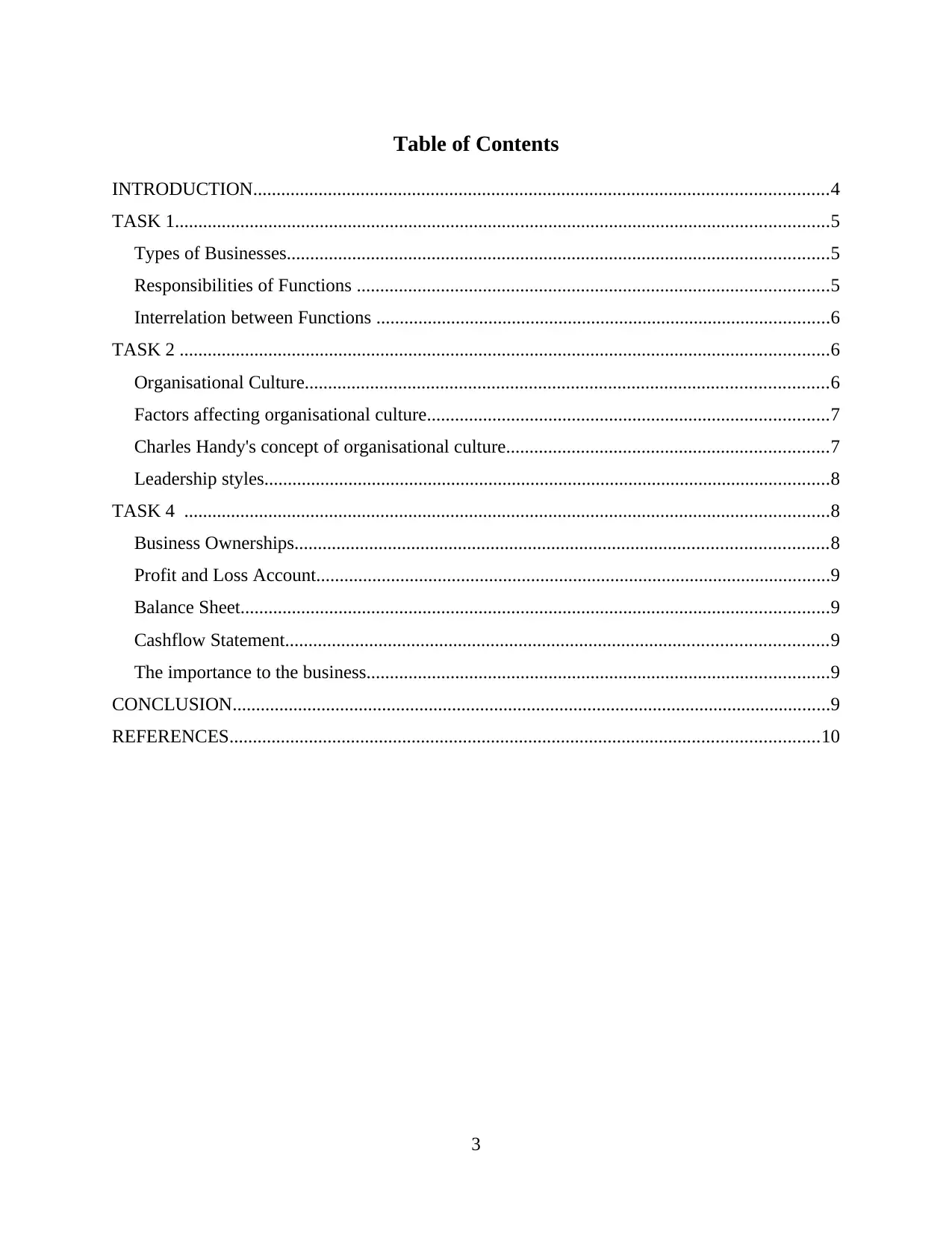
Table of Contents
INTRODUCTION...........................................................................................................................4
TASK 1............................................................................................................................................5
Types of Businesses....................................................................................................................5
Responsibilities of Functions .....................................................................................................5
Interrelation between Functions .................................................................................................6
TASK 2 ...........................................................................................................................................6
Organisational Culture................................................................................................................6
Factors affecting organisational culture......................................................................................7
Charles Handy's concept of organisational culture.....................................................................7
Leadership styles.........................................................................................................................8
TASK 4 ..........................................................................................................................................8
Business Ownerships..................................................................................................................8
Profit and Loss Account..............................................................................................................9
Balance Sheet..............................................................................................................................9
Cashflow Statement....................................................................................................................9
The importance to the business...................................................................................................9
CONCLUSION................................................................................................................................9
REFERENCES..............................................................................................................................10
3
INTRODUCTION...........................................................................................................................4
TASK 1............................................................................................................................................5
Types of Businesses....................................................................................................................5
Responsibilities of Functions .....................................................................................................5
Interrelation between Functions .................................................................................................6
TASK 2 ...........................................................................................................................................6
Organisational Culture................................................................................................................6
Factors affecting organisational culture......................................................................................7
Charles Handy's concept of organisational culture.....................................................................7
Leadership styles.........................................................................................................................8
TASK 4 ..........................................................................................................................................8
Business Ownerships..................................................................................................................8
Profit and Loss Account..............................................................................................................9
Balance Sheet..............................................................................................................................9
Cashflow Statement....................................................................................................................9
The importance to the business...................................................................................................9
CONCLUSION................................................................................................................................9
REFERENCES..............................................................................................................................10
3
⊘ This is a preview!⊘
Do you want full access?
Subscribe today to unlock all pages.

Trusted by 1+ million students worldwide
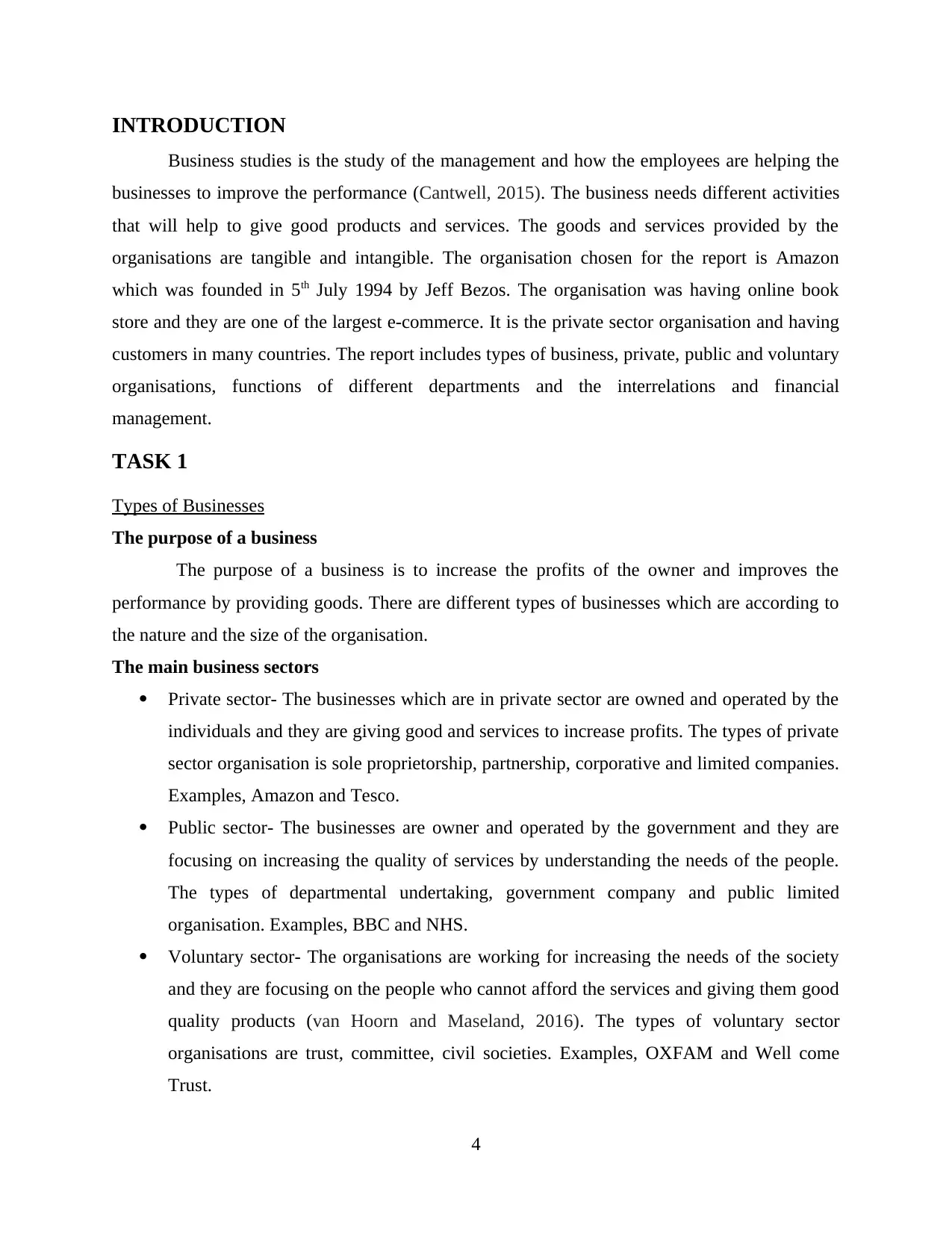
INTRODUCTION
Business studies is the study of the management and how the employees are helping the
businesses to improve the performance (Cantwell, 2015). The business needs different activities
that will help to give good products and services. The goods and services provided by the
organisations are tangible and intangible. The organisation chosen for the report is Amazon
which was founded in 5th July 1994 by Jeff Bezos. The organisation was having online book
store and they are one of the largest e-commerce. It is the private sector organisation and having
customers in many countries. The report includes types of business, private, public and voluntary
organisations, functions of different departments and the interrelations and financial
management.
TASK 1
Types of Businesses
The purpose of a business
The purpose of a business is to increase the profits of the owner and improves the
performance by providing goods. There are different types of businesses which are according to
the nature and the size of the organisation.
The main business sectors
Private sector- The businesses which are in private sector are owned and operated by the
individuals and they are giving good and services to increase profits. The types of private
sector organisation is sole proprietorship, partnership, corporative and limited companies.
Examples, Amazon and Tesco.
Public sector- The businesses are owner and operated by the government and they are
focusing on increasing the quality of services by understanding the needs of the people.
The types of departmental undertaking, government company and public limited
organisation. Examples, BBC and NHS.
Voluntary sector- The organisations are working for increasing the needs of the society
and they are focusing on the people who cannot afford the services and giving them good
quality products (van Hoorn and Maseland, 2016). The types of voluntary sector
organisations are trust, committee, civil societies. Examples, OXFAM and Well come
Trust.
4
Business studies is the study of the management and how the employees are helping the
businesses to improve the performance (Cantwell, 2015). The business needs different activities
that will help to give good products and services. The goods and services provided by the
organisations are tangible and intangible. The organisation chosen for the report is Amazon
which was founded in 5th July 1994 by Jeff Bezos. The organisation was having online book
store and they are one of the largest e-commerce. It is the private sector organisation and having
customers in many countries. The report includes types of business, private, public and voluntary
organisations, functions of different departments and the interrelations and financial
management.
TASK 1
Types of Businesses
The purpose of a business
The purpose of a business is to increase the profits of the owner and improves the
performance by providing goods. There are different types of businesses which are according to
the nature and the size of the organisation.
The main business sectors
Private sector- The businesses which are in private sector are owned and operated by the
individuals and they are giving good and services to increase profits. The types of private
sector organisation is sole proprietorship, partnership, corporative and limited companies.
Examples, Amazon and Tesco.
Public sector- The businesses are owner and operated by the government and they are
focusing on increasing the quality of services by understanding the needs of the people.
The types of departmental undertaking, government company and public limited
organisation. Examples, BBC and NHS.
Voluntary sector- The organisations are working for increasing the needs of the society
and they are focusing on the people who cannot afford the services and giving them good
quality products (van Hoorn and Maseland, 2016). The types of voluntary sector
organisations are trust, committee, civil societies. Examples, OXFAM and Well come
Trust.
4
Paraphrase This Document
Need a fresh take? Get an instant paraphrase of this document with our AI Paraphraser
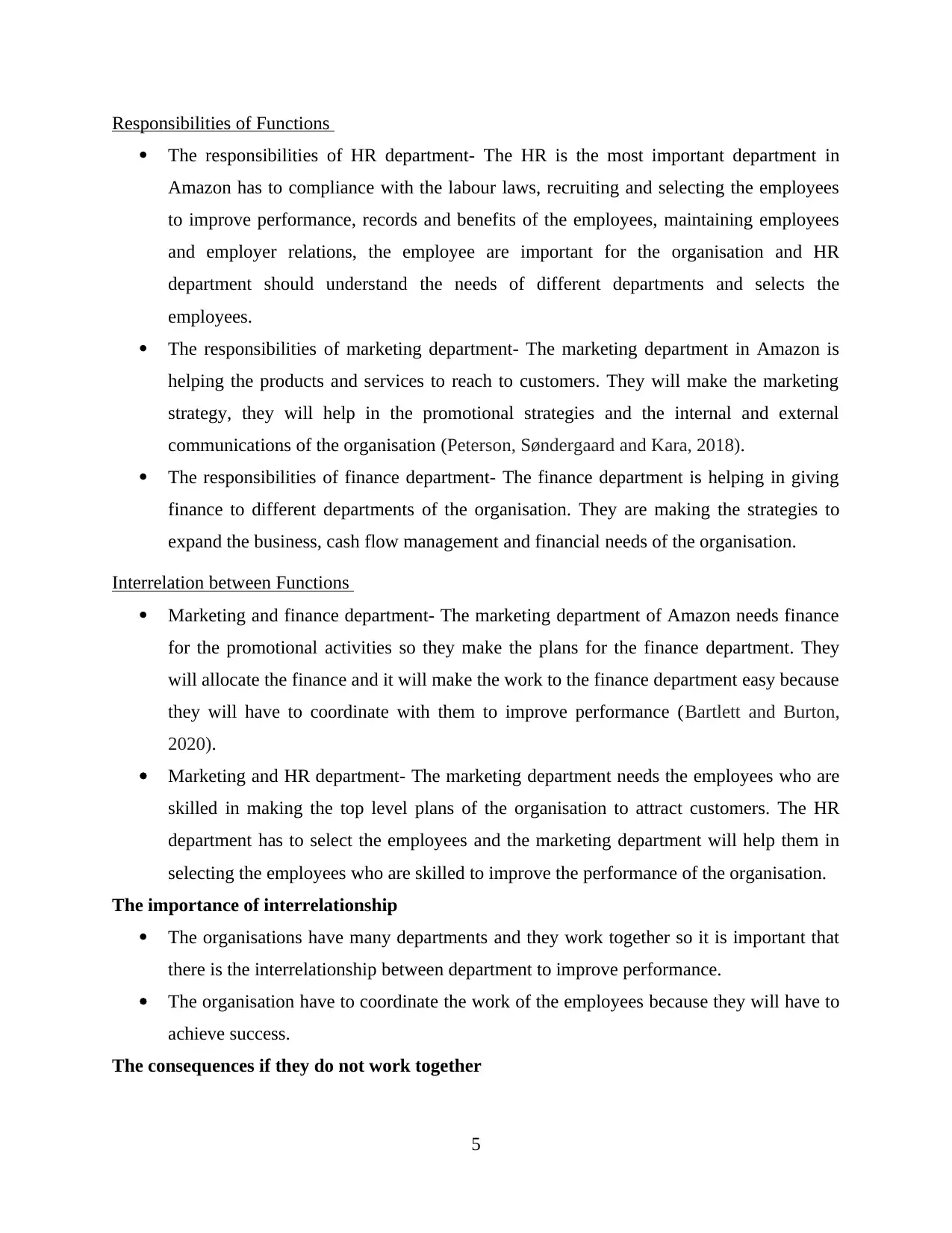
Responsibilities of Functions
The responsibilities of HR department- The HR is the most important department in
Amazon has to compliance with the labour laws, recruiting and selecting the employees
to improve performance, records and benefits of the employees, maintaining employees
and employer relations, the employee are important for the organisation and HR
department should understand the needs of different departments and selects the
employees.
The responsibilities of marketing department- The marketing department in Amazon is
helping the products and services to reach to customers. They will make the marketing
strategy, they will help in the promotional strategies and the internal and external
communications of the organisation (Peterson, Søndergaard and Kara, 2018).
The responsibilities of finance department- The finance department is helping in giving
finance to different departments of the organisation. They are making the strategies to
expand the business, cash flow management and financial needs of the organisation.
Interrelation between Functions
Marketing and finance department- The marketing department of Amazon needs finance
for the promotional activities so they make the plans for the finance department. They
will allocate the finance and it will make the work to the finance department easy because
they will have to coordinate with them to improve performance (Bartlett and Burton,
2020).
Marketing and HR department- The marketing department needs the employees who are
skilled in making the top level plans of the organisation to attract customers. The HR
department has to select the employees and the marketing department will help them in
selecting the employees who are skilled to improve the performance of the organisation.
The importance of interrelationship
The organisations have many departments and they work together so it is important that
there is the interrelationship between department to improve performance.
The organisation have to coordinate the work of the employees because they will have to
achieve success.
The consequences if they do not work together
5
The responsibilities of HR department- The HR is the most important department in
Amazon has to compliance with the labour laws, recruiting and selecting the employees
to improve performance, records and benefits of the employees, maintaining employees
and employer relations, the employee are important for the organisation and HR
department should understand the needs of different departments and selects the
employees.
The responsibilities of marketing department- The marketing department in Amazon is
helping the products and services to reach to customers. They will make the marketing
strategy, they will help in the promotional strategies and the internal and external
communications of the organisation (Peterson, Søndergaard and Kara, 2018).
The responsibilities of finance department- The finance department is helping in giving
finance to different departments of the organisation. They are making the strategies to
expand the business, cash flow management and financial needs of the organisation.
Interrelation between Functions
Marketing and finance department- The marketing department of Amazon needs finance
for the promotional activities so they make the plans for the finance department. They
will allocate the finance and it will make the work to the finance department easy because
they will have to coordinate with them to improve performance (Bartlett and Burton,
2020).
Marketing and HR department- The marketing department needs the employees who are
skilled in making the top level plans of the organisation to attract customers. The HR
department has to select the employees and the marketing department will help them in
selecting the employees who are skilled to improve the performance of the organisation.
The importance of interrelationship
The organisations have many departments and they work together so it is important that
there is the interrelationship between department to improve performance.
The organisation have to coordinate the work of the employees because they will have to
achieve success.
The consequences if they do not work together
5
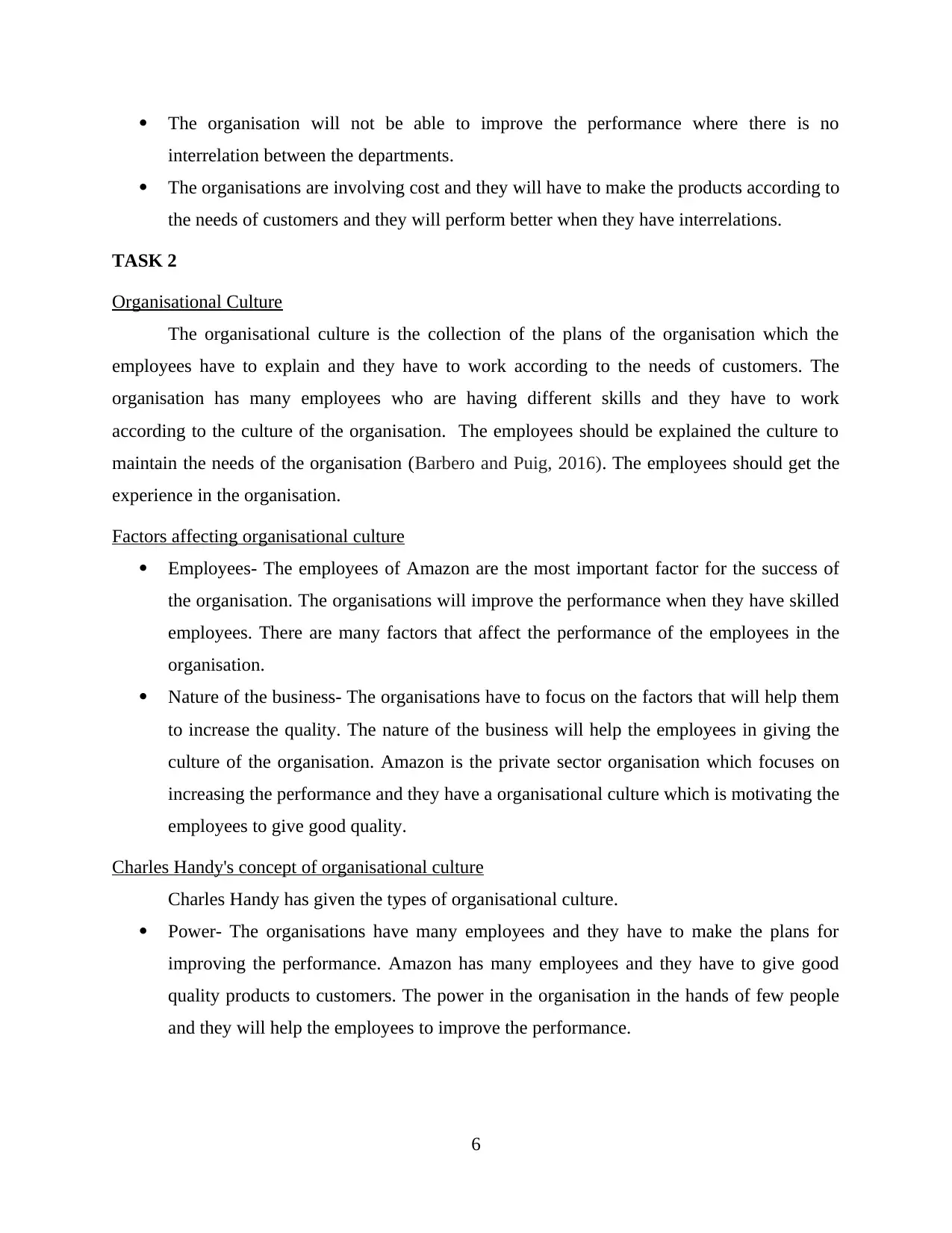
The organisation will not be able to improve the performance where there is no
interrelation between the departments.
The organisations are involving cost and they will have to make the products according to
the needs of customers and they will perform better when they have interrelations.
TASK 2
Organisational Culture
The organisational culture is the collection of the plans of the organisation which the
employees have to explain and they have to work according to the needs of customers. The
organisation has many employees who are having different skills and they have to work
according to the culture of the organisation. The employees should be explained the culture to
maintain the needs of the organisation (Barbero and Puig, 2016). The employees should get the
experience in the organisation.
Factors affecting organisational culture
Employees- The employees of Amazon are the most important factor for the success of
the organisation. The organisations will improve the performance when they have skilled
employees. There are many factors that affect the performance of the employees in the
organisation.
Nature of the business- The organisations have to focus on the factors that will help them
to increase the quality. The nature of the business will help the employees in giving the
culture of the organisation. Amazon is the private sector organisation which focuses on
increasing the performance and they have a organisational culture which is motivating the
employees to give good quality.
Charles Handy's concept of organisational culture
Charles Handy has given the types of organisational culture.
Power- The organisations have many employees and they have to make the plans for
improving the performance. Amazon has many employees and they have to give good
quality products to customers. The power in the organisation in the hands of few people
and they will help the employees to improve the performance.
6
interrelation between the departments.
The organisations are involving cost and they will have to make the products according to
the needs of customers and they will perform better when they have interrelations.
TASK 2
Organisational Culture
The organisational culture is the collection of the plans of the organisation which the
employees have to explain and they have to work according to the needs of customers. The
organisation has many employees who are having different skills and they have to work
according to the culture of the organisation. The employees should be explained the culture to
maintain the needs of the organisation (Barbero and Puig, 2016). The employees should get the
experience in the organisation.
Factors affecting organisational culture
Employees- The employees of Amazon are the most important factor for the success of
the organisation. The organisations will improve the performance when they have skilled
employees. There are many factors that affect the performance of the employees in the
organisation.
Nature of the business- The organisations have to focus on the factors that will help them
to increase the quality. The nature of the business will help the employees in giving the
culture of the organisation. Amazon is the private sector organisation which focuses on
increasing the performance and they have a organisational culture which is motivating the
employees to give good quality.
Charles Handy's concept of organisational culture
Charles Handy has given the types of organisational culture.
Power- The organisations have many employees and they have to make the plans for
improving the performance. Amazon has many employees and they have to give good
quality products to customers. The power in the organisation in the hands of few people
and they will help the employees to improve the performance.
6
⊘ This is a preview!⊘
Do you want full access?
Subscribe today to unlock all pages.

Trusted by 1+ million students worldwide
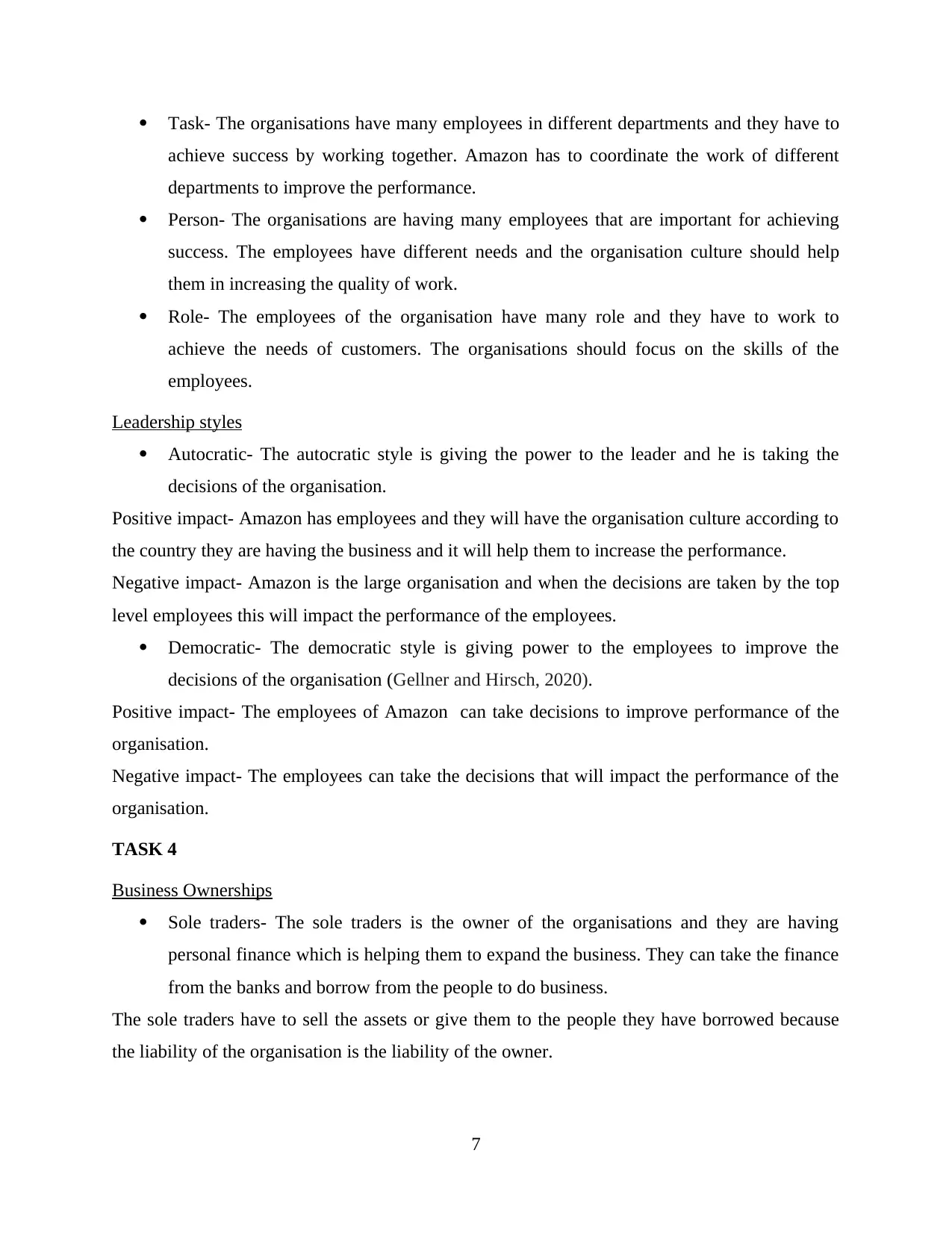
Task- The organisations have many employees in different departments and they have to
achieve success by working together. Amazon has to coordinate the work of different
departments to improve the performance.
Person- The organisations are having many employees that are important for achieving
success. The employees have different needs and the organisation culture should help
them in increasing the quality of work.
Role- The employees of the organisation have many role and they have to work to
achieve the needs of customers. The organisations should focus on the skills of the
employees.
Leadership styles
Autocratic- The autocratic style is giving the power to the leader and he is taking the
decisions of the organisation.
Positive impact- Amazon has employees and they will have the organisation culture according to
the country they are having the business and it will help them to increase the performance.
Negative impact- Amazon is the large organisation and when the decisions are taken by the top
level employees this will impact the performance of the employees.
Democratic- The democratic style is giving power to the employees to improve the
decisions of the organisation (Gellner and Hirsch, 2020).
Positive impact- The employees of Amazon can take decisions to improve performance of the
organisation.
Negative impact- The employees can take the decisions that will impact the performance of the
organisation.
TASK 4
Business Ownerships
Sole traders- The sole traders is the owner of the organisations and they are having
personal finance which is helping them to expand the business. They can take the finance
from the banks and borrow from the people to do business.
The sole traders have to sell the assets or give them to the people they have borrowed because
the liability of the organisation is the liability of the owner.
7
achieve success by working together. Amazon has to coordinate the work of different
departments to improve the performance.
Person- The organisations are having many employees that are important for achieving
success. The employees have different needs and the organisation culture should help
them in increasing the quality of work.
Role- The employees of the organisation have many role and they have to work to
achieve the needs of customers. The organisations should focus on the skills of the
employees.
Leadership styles
Autocratic- The autocratic style is giving the power to the leader and he is taking the
decisions of the organisation.
Positive impact- Amazon has employees and they will have the organisation culture according to
the country they are having the business and it will help them to increase the performance.
Negative impact- Amazon is the large organisation and when the decisions are taken by the top
level employees this will impact the performance of the employees.
Democratic- The democratic style is giving power to the employees to improve the
decisions of the organisation (Gellner and Hirsch, 2020).
Positive impact- The employees of Amazon can take decisions to improve performance of the
organisation.
Negative impact- The employees can take the decisions that will impact the performance of the
organisation.
TASK 4
Business Ownerships
Sole traders- The sole traders is the owner of the organisations and they are having
personal finance which is helping them to expand the business. They can take the finance
from the banks and borrow from the people to do business.
The sole traders have to sell the assets or give them to the people they have borrowed because
the liability of the organisation is the liability of the owner.
7
Paraphrase This Document
Need a fresh take? Get an instant paraphrase of this document with our AI Paraphraser
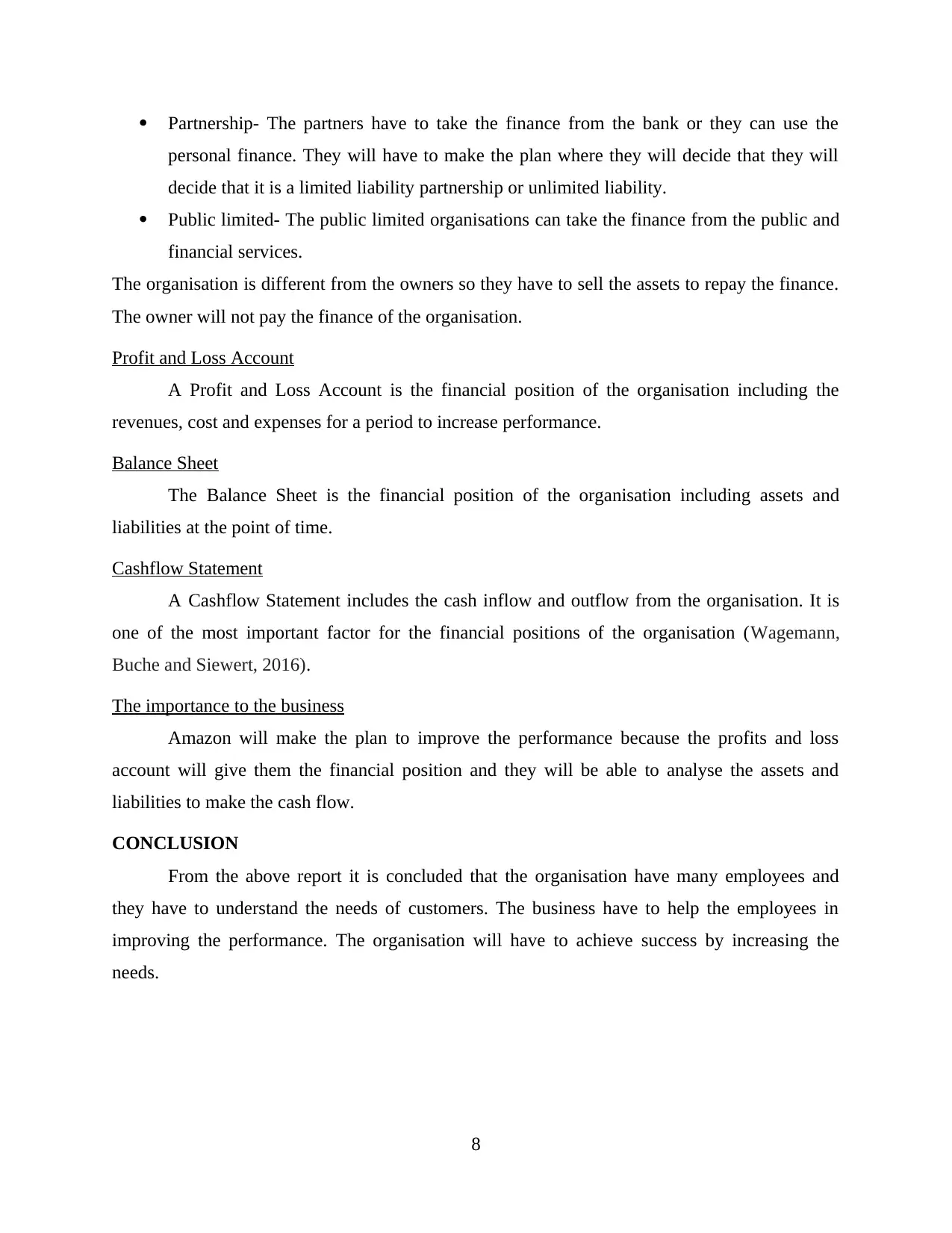
Partnership- The partners have to take the finance from the bank or they can use the
personal finance. They will have to make the plan where they will decide that they will
decide that it is a limited liability partnership or unlimited liability.
Public limited- The public limited organisations can take the finance from the public and
financial services.
The organisation is different from the owners so they have to sell the assets to repay the finance.
The owner will not pay the finance of the organisation.
Profit and Loss Account
A Profit and Loss Account is the financial position of the organisation including the
revenues, cost and expenses for a period to increase performance.
Balance Sheet
The Balance Sheet is the financial position of the organisation including assets and
liabilities at the point of time.
Cashflow Statement
A Cashflow Statement includes the cash inflow and outflow from the organisation. It is
one of the most important factor for the financial positions of the organisation (Wagemann,
Buche and Siewert, 2016).
The importance to the business
Amazon will make the plan to improve the performance because the profits and loss
account will give them the financial position and they will be able to analyse the assets and
liabilities to make the cash flow.
CONCLUSION
From the above report it is concluded that the organisation have many employees and
they have to understand the needs of customers. The business have to help the employees in
improving the performance. The organisation will have to achieve success by increasing the
needs.
8
personal finance. They will have to make the plan where they will decide that they will
decide that it is a limited liability partnership or unlimited liability.
Public limited- The public limited organisations can take the finance from the public and
financial services.
The organisation is different from the owners so they have to sell the assets to repay the finance.
The owner will not pay the finance of the organisation.
Profit and Loss Account
A Profit and Loss Account is the financial position of the organisation including the
revenues, cost and expenses for a period to increase performance.
Balance Sheet
The Balance Sheet is the financial position of the organisation including assets and
liabilities at the point of time.
Cashflow Statement
A Cashflow Statement includes the cash inflow and outflow from the organisation. It is
one of the most important factor for the financial positions of the organisation (Wagemann,
Buche and Siewert, 2016).
The importance to the business
Amazon will make the plan to improve the performance because the profits and loss
account will give them the financial position and they will be able to analyse the assets and
liabilities to make the cash flow.
CONCLUSION
From the above report it is concluded that the organisation have many employees and
they have to understand the needs of customers. The business have to help the employees in
improving the performance. The organisation will have to achieve success by increasing the
needs.
8
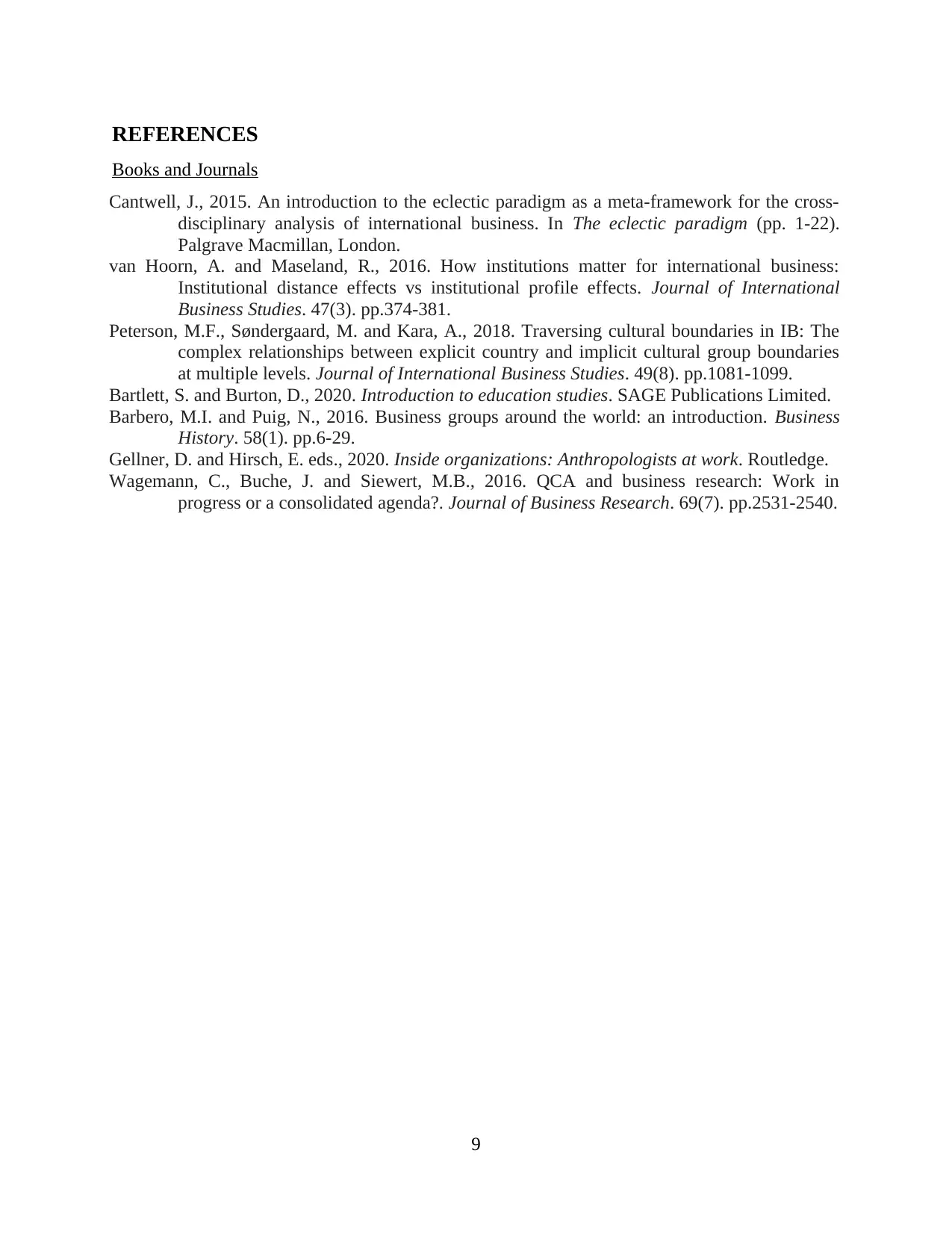
REFERENCES
Books and Journals
Cantwell, J., 2015. An introduction to the eclectic paradigm as a meta-framework for the cross-
disciplinary analysis of international business. In The eclectic paradigm (pp. 1-22).
Palgrave Macmillan, London.
van Hoorn, A. and Maseland, R., 2016. How institutions matter for international business:
Institutional distance effects vs institutional profile effects. Journal of International
Business Studies. 47(3). pp.374-381.
Peterson, M.F., Søndergaard, M. and Kara, A., 2018. Traversing cultural boundaries in IB: The
complex relationships between explicit country and implicit cultural group boundaries
at multiple levels. Journal of International Business Studies. 49(8). pp.1081-1099.
Bartlett, S. and Burton, D., 2020. Introduction to education studies. SAGE Publications Limited.
Barbero, M.I. and Puig, N., 2016. Business groups around the world: an introduction. Business
History. 58(1). pp.6-29.
Gellner, D. and Hirsch, E. eds., 2020. Inside organizations: Anthropologists at work. Routledge.
Wagemann, C., Buche, J. and Siewert, M.B., 2016. QCA and business research: Work in
progress or a consolidated agenda?. Journal of Business Research. 69(7). pp.2531-2540.
9
Books and Journals
Cantwell, J., 2015. An introduction to the eclectic paradigm as a meta-framework for the cross-
disciplinary analysis of international business. In The eclectic paradigm (pp. 1-22).
Palgrave Macmillan, London.
van Hoorn, A. and Maseland, R., 2016. How institutions matter for international business:
Institutional distance effects vs institutional profile effects. Journal of International
Business Studies. 47(3). pp.374-381.
Peterson, M.F., Søndergaard, M. and Kara, A., 2018. Traversing cultural boundaries in IB: The
complex relationships between explicit country and implicit cultural group boundaries
at multiple levels. Journal of International Business Studies. 49(8). pp.1081-1099.
Bartlett, S. and Burton, D., 2020. Introduction to education studies. SAGE Publications Limited.
Barbero, M.I. and Puig, N., 2016. Business groups around the world: an introduction. Business
History. 58(1). pp.6-29.
Gellner, D. and Hirsch, E. eds., 2020. Inside organizations: Anthropologists at work. Routledge.
Wagemann, C., Buche, J. and Siewert, M.B., 2016. QCA and business research: Work in
progress or a consolidated agenda?. Journal of Business Research. 69(7). pp.2531-2540.
9
⊘ This is a preview!⊘
Do you want full access?
Subscribe today to unlock all pages.

Trusted by 1+ million students worldwide
1 out of 9
Related Documents
Your All-in-One AI-Powered Toolkit for Academic Success.
+13062052269
info@desklib.com
Available 24*7 on WhatsApp / Email
![[object Object]](/_next/static/media/star-bottom.7253800d.svg)
Unlock your academic potential
Copyright © 2020–2025 A2Z Services. All Rights Reserved. Developed and managed by ZUCOL.





